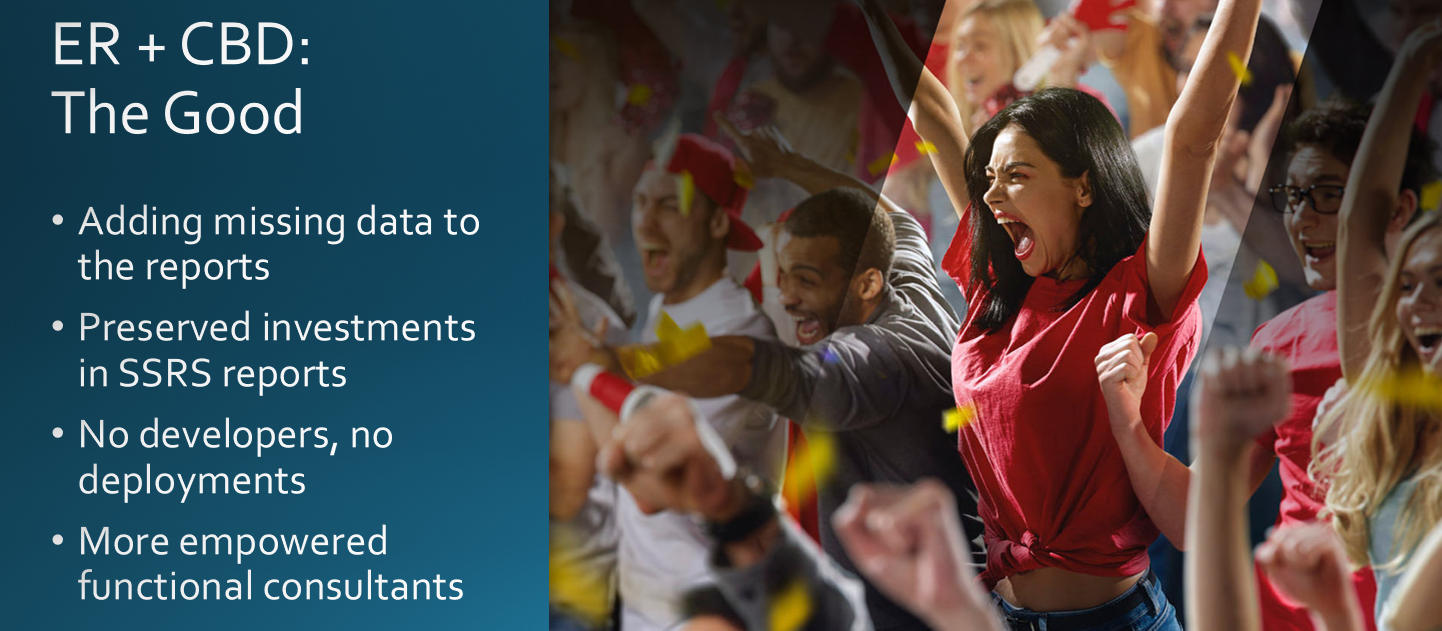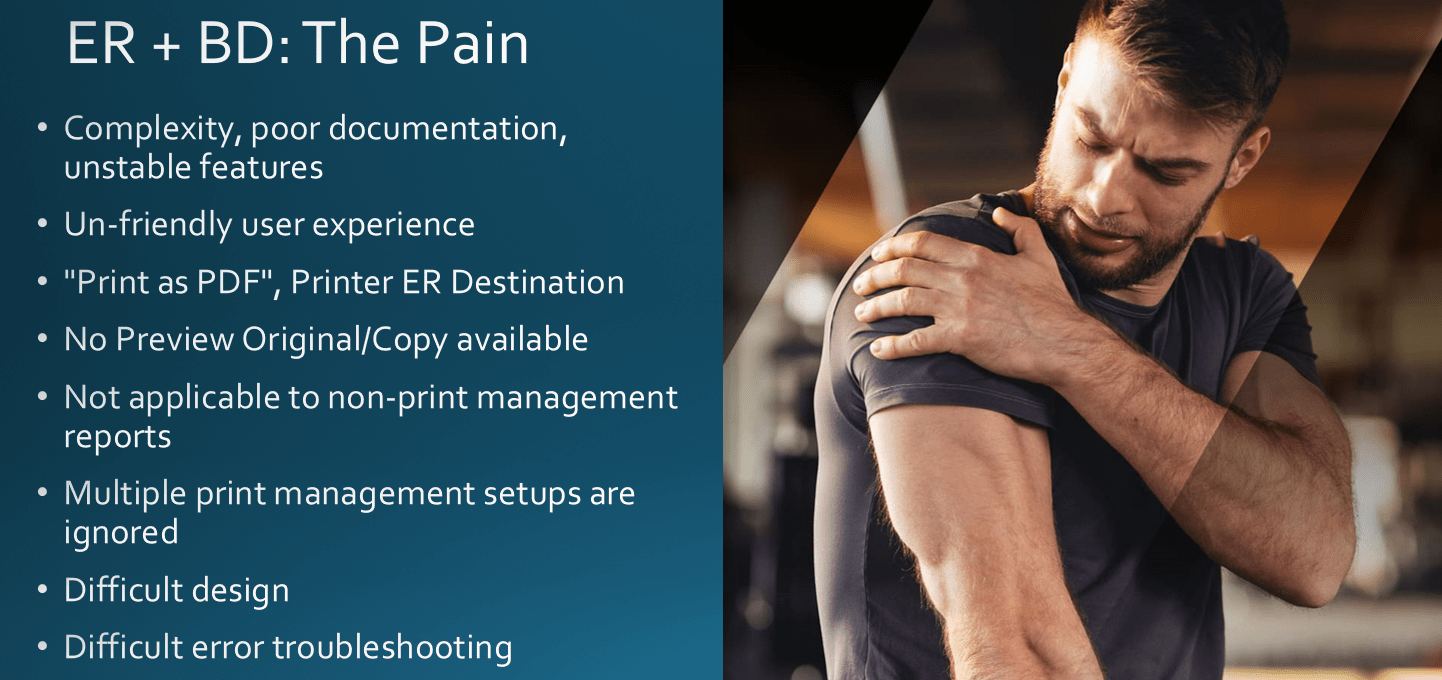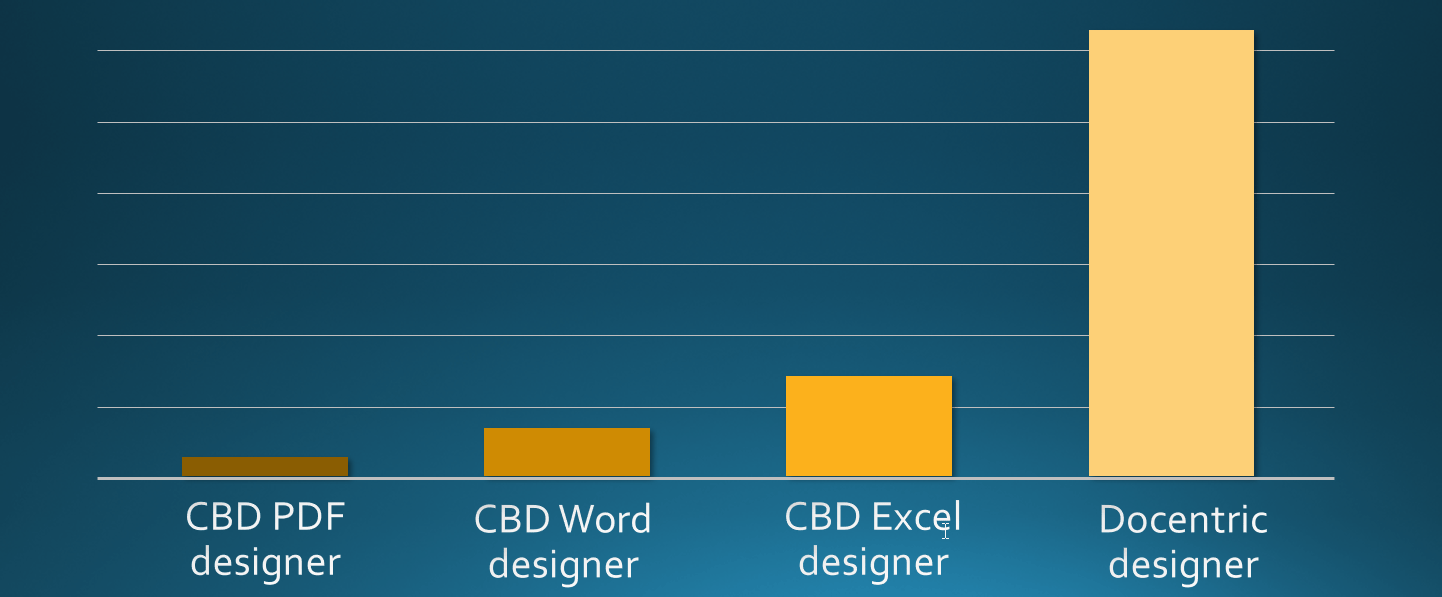It’s been almost half a year since most D365FO users had a chance to get hands-on with ER Business Documents. It was a long-expected improvement to SSRS, but how much of an improvement and how much complexity and downgrading to the existing functionality it brings, we will describe in this article. And even more, we will present our solution for embracing the good and solving the not-so-good from ER Business Documents.

In our previous articles and webinars
Ever since Microsoft announced the ER Configurable Business Documents (ER-CBD) in the middle of 2019, we at Docentric have been intensively working on learning everything about them. Very soon after that we published a series of articles on that topic:
- High-level overview of CBDs
- How we at Docentric see that we can improve CBD
- Comparison CBDs vs. Docentric
In the period from December till February we organized a series of 4 webinars on the same subject. The first 3 are a general introduction to Electronic Reporting (ER) and Configurable Business Documents (CBDs), while the last one was focused on Configurable Business Documents improved by Docentric:
Please note that Microsoft has recently started referring to CBDs as Business Documents (BD). We will follow that naming starting with this article.
In this article
This article presents the most important points from our last webinar. Our motive for writing is to give you a condensed overview of the material presented in the webinar. We have divided the webinar content into several video clips. Each section of this article points to one of them, thus allowing you to know in advance what to expect from each clip.
Webinar part 1/8: Introduction & Agenda
By looking back at the previous three webinars from the Business Documents in Electronic Reporting series, we remind our viewers of the content covered in them and announce the content of this webinar. As written in this article’s introduction, Docentric has merged the flexible ER datasource modelling capabilities with the user-friendly, time-saving Docentric designer and improved print destinations. In this way we deliver the Docentric Enhanced Business Documents to you, and that is the main topic of the mentioned webinar and of this article.

ER Business Documents bring the improvements which empower the functional consultants and very advanced end-users to customize the report datasources. In Microsoft’s own words:
- Business users will be able to change the document layout, add/remove the fields in the document and perform the simple data mapping.
- Consultants (power users) will be able to extend the data model and implement the complex formulas and complex mappings.
This is all true, but many negative aspects of this solution are not obvious until you start using it. Before you even decide to go that way, we want to give you a heads-up about the ER BD deficiencies and how Docentric solves them. Our webinar proves these statements through examples, while this article lists and briefly discusses the arguments demonstrated in the webinar.
We hope that the information presented will enable you to make an informed decision about the optimal solution for your reporting needs.
Watch Webinar part 1/8:
Webinar part 2/8: SSRS, CBD and Docentric
In the first half of this clip we present the different possibilities that arise with the introduction of ER-BD. We describe the main pain points of an SSRS only solution and how Docentric and ER-BD address them.
And in the second half we summarize in one place the biggest deficiencies of the plain ER-BD configuration. Depending on what matters to you, they can be a huge pain.

According to our opinion, these are the most frustrating points of the plain ER-BD solution:
- ER Business Documents are complex! They come with little and poor documentation, the technology is still immature and often unstable/buggy.
- User experience is poor. You get the Print Management-like forms as your main UI for designing the data models and bindings. Menu items are on unexpected places. UI and user actions are non-intuitive. It took our whole team a lot of time, effort and energy to just scratch the surface of ER Business Documents
- Some ER print destinations were initially missing, but with PU33 work-around solutions for them were provided, causing some performance and usability consequences – see the next two points for details.
- Save as PDF:
- It is solved by providing an additional check-box, therefore in the case of ER file print destination you get both Excel and PDF files.
- In our first tests, PDFs didn’t have a portrait orientation, they seemed to be generated on the square paper. This will probably be corrected at some point.
- The original (for example: Excel) format is converted into PDF through the on-line service, which isn’t supported for on-premises deployments
- Direct printing:
- It is solved by first generating a PDF document, which is then sent to DRA, which opens Adobe Acrobat from the command line to print it; all of that happens if DRA runs as a desktop app.
- On the other hand, if DRA runs as a service (which should be the preferred setup from the performance point of view), then PDFs can’t be sent directly to a printer, but they are stored on a network shared folder instead.
- Consequently, mass printing and batch printing won’t work reliably.
- Direct printing from ER assumes PDF conversion, therefore the custom fonts, including the barcode fonts, aren’t supported when Excel template is used.
- It is not possible to preview original/copy! You always get what is configured in ER destinations (which is a new set of print destinations), so there is no way to perform a quick check on a screen for non-batch situations.
- ER is applicable only to Print management reports. We can’t use it for some other often used Non-Print management reports such as Production order and Customer aging reports.
- It is not possible to combine the Docentric enhanced print destinations with ER. ER uses its own destinations, which are just slightly improved from the standard SSRS destinations.
- You can’t have multiple Print management setups (original, copy, special groups, etc.) with different print destinations, because Print management print destinations are ignored and ER print destinations are used.
- Designing the ER configurations is difficult, but manageable. You start from the Microsoft-provided model and model mapping configurations and customize them, typically to add more information to the report datasource.
- In most cases you will need to add the information from a table that has a relation to the default report datasource. With a little practice, both the end-users and consultants will become efficient with this.
- Less often, you will need to implement complex functions to reach the additional data. This will probably be done by the consultants, but, hey, end-users will be in charge for the simpler and most common requirements.
- Designing the Business Documents templates is a completely different story. It is really difficult, and we don’t believe that it will be widely accepted by the end-users. The available tools are buggy and slow, and we find working with them annoying and frustrating.
- None of the offered tools for designing the Business Documents templates, that is PDF, MS Word and MS Excel, is a specialized template designer tool!
- So far, the only document formats provided by Microsoft were the MS Excel templates. It seems that out of the three possibilities they offer the user experience which is by far the best, but is still far from a real template designer tool.
- You are using vanilla MS Excel, which doesn’t know anything about data filtering, grouping, conditionally showing and hiding, etc. Therefore, the datasource has to be prepared in the exact way it needs to be presented. For that, you are using format configurations with functions that can become way too complex.
- We don’t believe that end-clients will ever create a template from scratch, which was also Microsoft’s anticipation. They will depend on the configurations provided by Microsoft and/or modified by their implementation partner. They will probably add few fields to the design and make minor modifications in the layout, such as adding their logo and moving it around. So, end-clients are not empowered, they still depend completely on the implementation partner.
- When you need to add some complex data to the report, you make modifications everywhere: in the data model and model mapping, in the format and on the template. Then you run the report and if you don’t get the expected results, the only thing you can do is ask a developer to debug the code. You can’t test configurations separately. You will still need a developer to debug the report execution through the code. This also means that the consultants are not independent from the developers and the developers will be needed for a more frustrating job, debugging the ER model execution.
The architecture of this solution is presented below:
This solution is ready and will be published with one of our next releases. And that is not all! You won’t need to start from scratch, because the solution will be accompanied by a Docentric BD Replicas model, similar to our SSRS Replicas model.
Watch Webinar part 2/8:
Webinar part 3/8: CBD vs. Docentric emailing
The objective of this webinar part is to compare the experience of printing to the Email print destination, by using the plain ER-BD configuration and the Docentric enhanced BD.
Here we demonstrate printing of a Purchase order via email. We do it in two different scenarios:
- In the first scenario, we print by using the MS Excel Business Document template as prepared by Microsoft and we print to the ER Email destination. We demonstrate the limited possibilities and inconvenient user interface of this destination.
- In the second scenario, we print by using the same ER model, only this time through the Docentric replica of the Excel Business Document template. We configure the Docentric improved Email print destination and demonstrate its powerful features and intuitive user interface.
Watch Webinar part 3/8:
Webinar part 4/8: CBD Designer Demo
We demonstrate the experience of customizing a Business Document MS Excel template for Purchase order. Don’t be surprised, you will hear a lot of criticism during a simple example of adding a field, a task that is supposed to be performed by the end-users. Not that it is impossible, but stay with me and experience some of the pain that you should expect if you pick this route.
Watch Webinar part 4/8:
Webinar part 5/8: Docentric Designer Demo
To provide a fair comparison, we demonstrate the similar steps performed in the previous part, now in the Docentric designer. In a much shorter time, we show much more, because the task is done by using the better tool. Check this short demo and decide if that looks like something you would rather use in your everyday work.
Watch Webinar part 5/8:
Webinar part 6/8: CBD vs. Docentric Designer
In this part we discuss the template designers offered for ER Business Documents and we compare them among themselves and against Docentric designer. The objective is to compare the tools where development isn’t required, therefore SSRS is not taken into account.

Based on Docentric’s 10 years of expertise in this area, our large customer base and understanding of their needs, we have made a qualitative comparison of the features that we learned to be the most important for specialized template designer tools.
These are some of the criteria we used for the designer comparison:
- The user experience during the data-binding process is exceptionally important. How convenient is it? Do you have to repeat it over and over again while designing a template? Does it last 10 seconds (as in MS Excel) or does it happen immediately? Is there an overhead (e.g. specifying the named ranges in Excel) or do you need a minimal number of clicks?
- How well are data-bindings represented? Can you immediately see which design elements are bound to which data, or do you need additional clicks to check the data-bindings?
- How easy is it to modify or remove an existing data-binding?
- How easy is it to move an existing design element to another position? Do you need to create a completely new named range and open another tool (desktop Excel instead of online Excel) to cleanup and maintain the template, or is there simply no need to take care of it and everything happens “behind the scenes”?
- Does adding a new field in the document lines section ruin your whole layout?
- How are filtering, grouping, sorting and displaying of conditional content performed? In an intuitive way, by using the dedicated tools for each of the operations, directly in the designer, or by developing complex functions in the format configuration in order to shape the data in the exact way you need it to appear in the format?
- How well is data separated from a design? Can one person deal with a design and another with data?
- Do we have dynamic headers and footers, concept of pages, sections, etc. at our disposal? Those are the essentials for business documents such as Sales invoice and Purchase order.
- How is testing against the different data sets and languages performed? Do you need to publish the template, find or create a context record (e.g. sales order) against which you want to test it and then execute the report? Or can you work off-line in the template designer and test different scenarios without leaving the designer?
- How is debugging of unexpected results performed? If your custom field doesn’t appear in the output document or doesn’t have the value you expect, can you intercept the data coming from the datasource and inspect it, or do you need a developer to debug the code?
Watch Webinar part 6/8:
Webinar part 7/8: Print Management
When you use Docentric enhanced Business Documents as well as Docentric enhanced SSRS, the Print Management as we know it works automatically. Docentric applied so many improvements to the standard SSRS print destinations that it would be a real shame if you wouldn’t be able to use them any longer. We made a special effort to keep all of these improvements available, also in combination with Electronic Reporting. This part demonstrates the Docentric improved Email, File and Printer print destinations.
Watch Webinar part 7/8:
Webinar part 8/8: Conclusion
You can hear a few of our final thoughts on ER and Docentric enhanced Business Documents.
 Improved Electronic Reporting Business Documents
Improved Electronic Reporting Business Documents 
 Tags: Configurable business documents, D365FO, Electronic reporting, Video
Tags: Configurable business documents, D365FO, Electronic reporting, Video 

